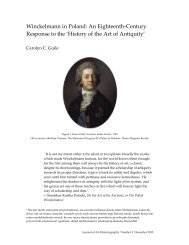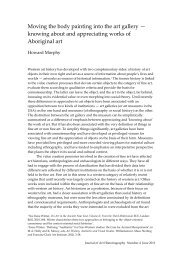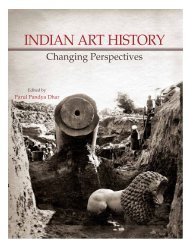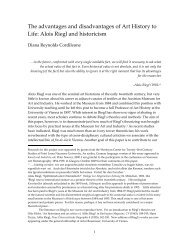9/SM1 - Journal of Art Historiography
9/SM1 - Journal of Art Historiography
9/SM1 - Journal of Art Historiography
You also want an ePaper? Increase the reach of your titles
YUMPU automatically turns print PDFs into web optimized ePapers that Google loves.
Stefan Muthesius<br />
Towards an ‘exakte Kunstwissenschaft‘(?)<br />
an ‘object <strong>of</strong> contemplation’. 165 Rößler underpins this further with Schopenhauer’s<br />
claims that ‘the subjectivity <strong>of</strong> the spirit dissolves itself through its complete<br />
objectivisation in contemplation’, 166 in effect uniting subject and object, and this<br />
applies to both the creator and the beholder. In such a way the revelation <strong>of</strong> the idea<br />
<strong>of</strong> beauty 167 is achieved as well as a depiction <strong>of</strong> the scene in the atelier in a ‘pure<br />
and objective way’. 168<br />
A special nugget in Justi’s Velasquez book, which could be - according to<br />
one’s standpoint - most disturbing, when applying the principles <strong>of</strong> a truth-telling<br />
Wissenchaft, or tantalisingly interesting when judging the book as a work <strong>of</strong><br />
literature: firstly there is the ‘Dialogue on Painting’, 169 in which a number <strong>of</strong> Roman<br />
painters discuss approaches to art and, secondly, further on in Justi’s book, one<br />
finds a long letter which the artist wrote back to his family from Rome. 170 Both these<br />
sections are totally Justi’s own inventions, though he does not acknowledge this<br />
fact. Neither did any <strong>of</strong> his early readers seem to have discovered it. Finally Justi<br />
confessed and was duly accused <strong>of</strong> having damaged the integrity <strong>of</strong> German<br />
Wissenschaft. 171<br />
But why not? In twenty pages Rößler provides a complex analysis <strong>of</strong> these<br />
texts, using epistemological arguments and those derived from literary<br />
presentational techniques. While admitting that what Justi did would not have been<br />
allowed in any pr<strong>of</strong>essional writing after 1900, 172 in the context <strong>of</strong> the basic outlook<br />
shared by all three books reported here, by Locher and by Prange, too, namely that<br />
one should not, and cannot, insist on too rigid a separation between fictional and<br />
objective-scientific texts, one may begin to accept Justi’s fictions as a kind <strong>of</strong><br />
‘literarisation’, serving the understanding <strong>of</strong> at least some <strong>of</strong> the overall arguments<br />
in the historical discussions on art. Rößler’s conclusion about the fakes is here given<br />
in full:<br />
Conclusion:<br />
If one returns once again to the starting point <strong>of</strong> the methodological<br />
controversies <strong>of</strong> 1880, one realises that the fictional sources inserted into the<br />
biography <strong>of</strong> Velazquez, may, last but not least, be understood when<br />
diagnosing them against the background <strong>of</strong> the time. Justi’s ideas <strong>of</strong><br />
presenting the issues gained their contours in the immediate proximity <strong>of</strong><br />
the dispute about the right connoisseurial procedure, whose protagonist<br />
was Giovanni Morelli. While Morelli, with the help <strong>of</strong> the fiction <strong>of</strong> a<br />
“Russian” and through openly ridiculing the adversary brought about a<br />
polarising constellation, Justi included the polemical impulse into his<br />
165<br />
‘“Gegenstand der Contmplation”’, Rößler, aftrer Schopenhauer, 280.<br />
166<br />
‘ … hebt sich die Subjektivtiät des Geistes durch seine volkommene Objektivierung in der<br />
Anschauung auf’, Rößler, 284.<br />
167<br />
‘Die Offenbarung der Idee des Schöenen’, Rößler, 285.<br />
168<br />
‘Rein und objektiv’, Rößler, 285.<br />
169<br />
‘Intermezzo: Dialog über die Malerei, in: ‘Erstes Buch’.<br />
170<br />
In: ‘Drittes Buch’, ‘Rom im Jahre 1630’.<br />
171<br />
‘Die Ehre deutscher Wissenschaft’, Rößler, 233.<br />
172<br />
Rößler, 233.<br />
33
















